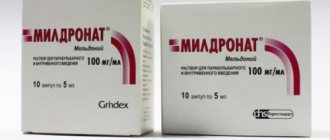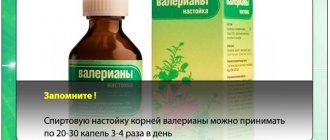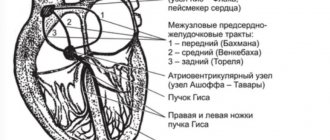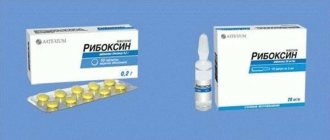Good afternoon, my readers!
Today we will talk about two healthy drugs, their differences and similarities and find out whether they can be taken together and which is better? As you may have guessed from the title, we will talk about Panangin and Riboxin, at the beginning I decided to describe the complete instructions for Riboxin, first for intravenous administration, and then for tablets, in order to close this issue for you and make this article almost independent, so that you can read it opened it and immediately found the information you were interested in. The full instructions for the second drug can be read here. After the instructions, I will describe the effect of both of these drugs on the body as a whole, and you and I will draw conclusions from all of this. Also, there will be a few words about reviews. Links to sources, as always, are below the article. Enjoy reading!
Panangin and Riboxin are medications used in cardiological practices to prevent heart attacks and improve metabolism in the myocardium. In the pharmacological classification of ATC, panangin is designated by the code A12CC30, and riboxin by C01EB.
When to take Riboxin
The medication is intended for the treatment of heart diseases, treatment and prevention of heart attacks. The product normalizes myocardial functions, activates metabolism, and evens out blood circulation. The substance accelerates tissue restoration and normalizes the supply of oxygen to the myocardium. The medicine is available in tablets and in the form of liquid for injections. The active ingredient is inosine.
Indications: inflammation in the myocardium, ischemia, heart disease, heart attack, arrhythmia, atherosclerosis, alcohol or drug poisoning, stomach ulcer, severe liver damage.
Drug interactions and compatibility
Riboxin can enhance the effect of antiviral drugs. It has been noted that the drug may slightly reduce the effect of antifungal agents. Information about additional interactions can be found in the instructions for the drug.
Panangin may enhance atrioventricular block caused by beta-blockers or slow calcium channel blockers.
Is it possible to take Riboxin and Panangin together? Intravenous administration of Riboxin in the form of a dropper can enhance the positive effect of macroelements on the structural and physiological state of the heart muscle. The hypotensive effect and antiarrhythmic effect can also be enhanced by combining the two medications.
It is possible to take medications only after consulting a doctor. You should not use the above substances on your own, as they can cause unpredictable harm to some patients.
Sources: www.tiensmed.ru/news/riboxinus1.html lekarstvie.ru/kardiologiya/riboksin.html www.vidal.ru/drugs/riboxin__32436 lechiserdce.ru/preparatyi/18834-panangina-ili-riboksina-chto-luchshe.html
Why is Panangin prescribed?
The medication restores the level of potassium and magnesium in the blood. It is used for heart pathologies, arrhythmia, and in cases where it is necessary to eliminate the lack of elements. The main active ingredients of the drug are potassium and magnesium.
Potassium restores nerve impulses in the myocardium. Magnesium helps store energy in the body and increases the efficiency of oxygen supply to cells. Release form: tablets and liquid for injections into a vein. Panangin treats arrhythmia and eliminates micronutrient deficiencies, improves metabolism, treats ischemia, and helps the formation of proteins.
Panangin restores the level of potassium and magnesium in the blood.
Discussion, answers to questions. Kuznetsova I.V.
Vladimir Trofimovich Ivashkin , academician of the Russian Academy of Medical Sciences, Doctor of Medical Sciences:
– Irina Vsevolodovna, hello. Thank you very much for your very interesting lecture. I have a few questions because your lecture evokes so many associations. Please tell me you are talking about patients with dysmenorrhea. Are these patients with long, heavy periods or not necessarily?
Irina Vsevolodovna Kuznetsova , professor, doctor of medical sciences:
- Thank you very much. We have a mixed audience, so I'll just clarify. The term dysmenorrhea is currently interpreted in gynecology as painful menstruation; this is pathological pain that lasts more than 24 hours in the first days of menstruation. It may, of course, be accompanied by more abundant bleeding, but this is not necessary; it is designated by another term - menorrhagia. But dysmenorrhea itself in its pure form is painful menstruation. It can be primary, that is, it arises precisely as a result of a violation of prostaglandin metabolism, usually in young women, or it can be secondary as a result of endometriosis, as a result of inflammatory processes of the pelvic organs, and so on.
Ivashkin V.T.:
- One more question. You mentioned that the combination of magnesium and vitamin B6 could prevent colon cancer. You see, as a gastroenterologist who is actively interested in this problem, I’m hearing this for the first time. And today, of all possible means of prevention, the only thing that has been proven with certainty is that long-term use of aspirin, and then only in patients in whom there is an increase in type 2 oxygenase in detectable polyps, in this case aspirin has such a preventive effect. As for magnesium and vitamin B6, I wonder what points of application, at what stage they can have a preventive effect?
Kuznetsova I.V.:
– By analogy with aspirin, I can assume that this is also cyclooxygenase, since it is associated with the synthesis of prostaglandins, but this is only an assumption.
Ivashkin V.T.:
– Magnesium is not a cyclooxygenase inhibitor.
Kuznetsova I.V.:
– It is not an inhibitor, I completely agree with you. But also, for example, hormonal drugs, while not inhibitors, are nevertheless capable of increasing or decreasing the expression of type 2 cyclooxygenase.
Ivashkin V.T.:
– You see what’s the matter, colon cancer, colorectal cancer is the first most common cancer among gastrointestinal cancers, and its frequency in Russia is very high. To make a recommendation to take magnesium and vitamin B6 for the purpose of cancer prevention, this still requires data from randomized trials.
Kuznetsova I.V.:
– I do not give such recommendations under any circumstances.
Ivashkin V.T.:
– It seems to me that such assumptions among a wide audience about the possibility of vitamin B6 and magnesium somehow influencing the incidence of colorectal cancer are premature, and it may be inappropriate to discuss this issue among a wide audience.
Kuznetsova I.V.:
– I completely agree with you, and, as you noted, I did not give this either in conclusions or in recommendations. She simply indicated that such a consideration had been put forward. Yes, indeed this is a very controversial issue, as controversial as the reduction in the incidence of colorectal cancer with the use of combined oral contraceptives or hormone replacement therapy, although there are randomized and controlled studies, and large epidemiological studies on this. But nevertheless, these studies cannot in any way serve as a basis for offering this remedy as a prevention of this disease, certainly not.
Oksana Mikhailovna Drapkina , professor, doctor of medical sciences:
– Irina Vsevolodovna, they write to us: “Ulan-Ude is also with you.” The question is: what should be the duration of the Magne B6 course and how often should it be repeated?
Kuznetsova I.V.:
– I believe that the optimal duration of the course is a three-month course, at least in our practice of treating patients with premenstrual syndrome with menopausal syndrome, with dysmenorrhea it is usually a three-month course of treatment. And this, of course, is not monotherapy; it is woven into the complex of therapy for these diseases. As for the need to repeat courses - depending on the situation of the disease. That is, in this case, I do not consider the use of magnesium preparations as a preventive measure that would be aimed at preventing one or another gynecological symptoms. These are the drugs that are introduced into the therapy complex if there are corresponding symptoms.
Drapkina O.M.:
– Our viewers are concerned about the question: is it possible to overdose on vitamin B6? That is, we understand that magnesium is not so scary and dangerous, but what about vitamin B6?
Kuznetsova I.V.:
- No. At the doses in which it is prescribed, an overdose of vitamin B6 has not been described, so there is no concern here.
Drapkina O.M.:
– What courses should I take magnesium supplements, how often should I monitor my blood magnesium levels during treatment?
Kuznetsova I.V.:
– There is no need to monitor blood magnesium levels during treatment. And I said the duration of the course above: for me, a three-month course seems optimal. Perhaps neurologists continue this treatment with longer courses, but from a gynecological point of view, a three-month course is adequate.
Drapkina O.M.:
– What are the objective methods for diagnosing magnesium deficiency? And are there specific indications for prescribing magnesium supplements?
Indeed, clinically, not only in a woman, and not only in a woman of reproductive age, but also in a man, can a deficiency be suspected in any person? The only thing that comes to my mind is heart rhythm disturbances.
Kuznetsova I.V.:
– And convulsive symptoms. You understand, of course, these symptoms are very non-specific. Different completely deficiencies give similar symptoms. As a gynecologist, I can speak about premenstrual syndrome and menopausal syndrome as magnesium deficiency conditions. You yourself saw from the slide show, and you know this from clinical practice, that indeed, the symptoms of magnesium deficiency are very similar to the symptoms of estrogen deficiency, and in some cases to the symptoms of calcium deficiency, such as cramps in the calf muscles. That is, sometimes it is very difficult to separate certain nonspecific symptoms from each other, and it is impossible to talk about magnesium deficiency based on symptoms alone. Therefore, I once again return to the fact that it is in our gynecological practice that we talk about diseases that are more associated with magnesium deficiency. I don’t presume to say how to deal with men, you probably know better.
Drapkina O.M.:
– Vladimir Trofimovich, in our therapeutic clinic?..
Ivashkin V.T.:
– It’s generally difficult for me to imagine how to diagnose isolated magnesium deficiency in clinical practice. Firstly, there are no clinical symptoms to suspect magnesium deficiency. Secondly, there is essentially no instrumental data. Let's take, for example, an ion like potassium. These are practically twin brothers: magnesium-potassium are two intracellular elements, both are essential for the functioning of sodium-potassium ATPase. Magnesium is a cofactor for the sodium-potassium ATPase, and all of these symptoms that have been described can essentially indicate potassium deficiency. And all those drugs that were used before, for example Panangin, were a combination of magnesium and potassium. This combination was aimed at activating the sodium-potassium ATPase. Sodium-potassium ATPase is necessary to maintain the transmembrane potential, therefore the convulsive syndrome that is described is characteristic of calcium deficiency, magnesium deficiency, and potassium deficiency, since in all these cases the transmembrane potential changes, and the excitability threshold decreases, and, Accordingly, depolarization processes are disrupted. Therefore, it is very difficult to say that it is magnesium deficiency that underlies all these manifestations. I think that here the combination of magnesium, potassium and calcium cations, a kind of triad, may to some extent explain the varied symptoms that we encounter.
Drapkina O.M.:
– Olga Vladimirovna will add.
Olga Vladimirovna Kotova , associate professor, candidate of medical sciences:
– I am a neurologist and would like to add something about magnesium deficiency. Quite recently, a dissertation on tension headaches was defended at our university. And there, magnesium deficiency was shown and proven in patients with tension headaches. In complex therapy with the use of Magne B6, accordingly, greater results were obtained than in traditional therapy of just tension headaches. And this was proven by the composition, they looked at hair as the most harmless way to study the deficiency.
Drapkina O.M.:
– Yes, it accumulates in the hair.
And they just echo Vladimir Trofimovich’s assumption about Panangin. The viewer also asks a question: wouldn’t it be more correct to prescribe Panangin to compensate for magnesium deficiency? Thanks for the answer.
Kuznetsova I.V.:
– But Panangin is still a complex drug, it contains magnesium and potassium. You understand, there is no “magnesium deficiency” disease, just as there is no “calcium deficiency” disease. There are no such symptoms, so we are saying that there are some diseases that are largely associated with a deficiency of this microelement. As Olga Vladimirovna wonderfully said, thank you for your support - tension headaches are associated with magnesium deficiency. Also, again, I return to the fact that our diseases, menopausal and premenstrual syndrome, are associated precisely with magnesium, and not with potassium deficiency. Therefore, the administration of potassium - studies were conducted - did not lead to positive changes. And the administration of the drug Magne B6 really gave a good positive effect. Of course, there are probably some nuances in the symptoms, because after all, when such an emotional and mental spectrum of disorders predominates in our patients, plus convulsive, spasmophilic disorders, then we can suspect magnesium deficiency to a greater extent. If there is a tendency, say, to swelling, then we may encounter a deficiency of other microelements.
As for calcium, when we talk about premenopause and postmenopause, there are simply no questions - this is always a calcium-deficient age, and therefore we also add calcium supplements there. And, of course, I completely agree with Vladimir Trofimovich, because of course not only the replenishment of magnesium and vitamin B6, but also other drugs, other microelements, other vitamins are also needed in order to maintain health and solve the problems that come with us a patient.
Drapkina O.M.:
– The question is this: almost all pregnant women are prescribed magnesium. Does it have hepatotoxicity?
Kuznetsova I.V.:
– This question is probably not for me. But I’ll probably say a few words about the fact that indeed all pregnant women are prescribed magnesium supplements. Maybe not for everyone, but it is prescribed very often, probably more often than it should. Polypharmacy during pregnancy is, of course, scary. Absolutely not all pregnant women need magnesium and vitamin B supplements. Moreover, there are vitamins that are much more important for pregnancy, for example, folic acid, which is absolutely necessary for the development of the child and the prevention of some complications associated with hyperhomocysteinemia. But as for Magne B6, its use during pregnancy should, of course, be limited to certain indications, but this has not yet been done. I think that I cannot judge him regarding hepatotoxicity; I have not seen hepatotoxic effects during pregnancy in patients taking magnesium supplements.
Drapkina O.M.:
– From Vladikavkaz, a question: can children with hyperactivity take Magne B6? It's probably good when a child is hyperactive?
Kuznetsova I.V.:
– No, this is not good, but this is not a question for me, this is for neurologists. Thanks a lot.
Kotova O.V.:
– Sorry for interfering, but magnesium for hyperactivity in children is perhaps the safest drug on the entire list that we can offer, from antidepressants to antipsychotics, so we start with more neutral drugs.
Drapkina O.M.:
– What does hyperactivity mean?
Kotova O.V.:
– Attention deficit disorder, ADHD, in short. Excuse me, I am interfering with my neurological topic, or rather, it is semi-psychiatric, because ADHD very often turns into autism, and then not even neurological, but psychiatric problems.
Drapkina O.M.:
- Thanks a lot. Vladimir Trofimovich?
Ivashkin V.T.:
– I think this is a very interesting point of view on the role of magnesium, of course, we should support. I think that it is still necessary to narrow the niche for the use of magnesium, since the extreme expansion of this niche devalues the real significance of this drug. Otherwise, it turns out that you don’t need to control it: you don’t need to control the dosage, you don’t need to control the concentration, and so on - it essentially turns into mineral water, which you can drink in unlimited quantities, without controlling the flow of ions, and so on. Therefore, it seems to me that there should still be a fairly clearly defined niche for those nosological conditions or those syndromes for which this combination of vitamin B6 and magnesium should be used.
Then it’s not entirely clear why exactly this combination? Vitamin B6 is important for protein metabolism, magnesium is a cofactor in maybe a hundred or more different intracellular reactions. Why this combination? In the next lecture, it might be advisable to tell you about this.
Next, of course, it is very important to tell the transport system of magnesium ions: how the magnesium ion enters the cell, the systems for regulating the entry of magnesium into the cell and the exit of magnesium from the cell; is it an active process or a passive one; and how magnesium transport can be controlled at the level of the cell membrane. Here are these three questions: why the combination of vitamin B6 and magnesium, then the transport processes of magnesium, and yet a clearer limitation of nosological conditions and syndromes in which the effect of magnesium was actually obtained using randomized or sequential observations, of course, this would greatly enhance position of this drug.
Drapkina O.M.:
– Thank you very much, Irina Vsevolodovna, for the lecture and for the numerous questions that you had to answer. Thank you and see you next time.
Kuznetsova I.V.:
– Thank you very much, see you later.
How to take Riboxin and Panangin together
Riboxin is used in the form of intravenous drips. It increases the effect of nutrients on the condition of the myocardium. The hypotensive effect is enhanced when used together. For arrhythmia, Riboxin is prescribed in injections or tablets before meals.
The initial dose is 600-800 mg. You should take tablets 3-4 times a day. Dosages can be increased to 1200-2400 mg per day. The course of treatment is 1-3 months. Intravenous injections start with 200 mg. Give 1 injection per day. The dosage can be increased to 400 mg per day.
The course of therapy is 10-15 days. Droppers are prescribed for acute arrhythmia. Dose – 200-400 mg. Panangin tablets are taken after meals, 1-2 tablets 3 times a day. Panangin solution is administered intravenously, 1 ampoule every 4-6 hours.
For athletes, these drugs are used to increase endurance. Bodybuilders use 2.5 g per day.
The dose is calculated as follows: 0.15 g of the drug is prescribed per 10 kg of body weight. This remedy helps build muscle mass.
For arrhythmia, Riboxin is prescribed in injections or tablets before meals.
Indications for use
Riboxin was used in the 1970s in Eastern countries to improve athletic performance. However, clinical trials did not show statistically significant improvements. Inosine has been shown to have neuroprotective properties and is therefore used as an adjuvant therapy for spinal cord injury. The active substance improves axonal reorganization. Studies have also shown that the drug can improve the functional status of patients who have suffered strokes.
After oral administration, Riboxin promotes the synthesis of uric acid, which is considered a natural antioxidant. The drug also inhibits the activity of peroxynitrite. Peroxynitrite is involved in the pathogenesis of axonal process degeneration. In 2003, a study was launched at the University of Pennsylvania on the effect of riboxin on the development of multiple sclerosis. The study was completed in 2006, but the results have not yet been published. New publications indicated potential benefit, but the sample size (16 patients) was too small to draw a definitive conclusion. In addition, a side effect of treatment was the development of kidney stones in 4 of 16 patients. Thus, more research is needed to prove the effectiveness of the treatment.
Phase 2 trials for Parkinson's disease have now been completed. Early trials showed that patients with the highest serum urate levels had lower progression of parkinsonian symptoms. The study uses inosine to increase urate levels. Researchers say that uric acid salts can slow down the development of parkinsonism. Some sources claim that the drug has an antiviral effect. However, clinical trials evaluating the antiviral activity of the drug have not been conducted.
Potassium and magnesium have antihypoxic, membrane-stabilizing and hypotensive effects. The combination is used to treat anxiety, arrhythmias caused by electrolyte disturbances, hypoxia, and as an adjuvant therapy for essential hypertension.
Reviews
Doctors and patients leave their comments about the combined use of these drugs.
Doctors
Nikolsky Vladimir Mikhailovich, cardiologist
These drugs are used to treat patients after a heart attack. They quickly restore the body, normalize metabolism, saturate the blood with oxygen, and normalize blood circulation.
Maltseva Tatyana Sergeevna, cardiologist
For arrhythmia, a combination of these medications is often prescribed. With this treatment, blood circulation in the vessels and oxygen supply to tissues are improved.










